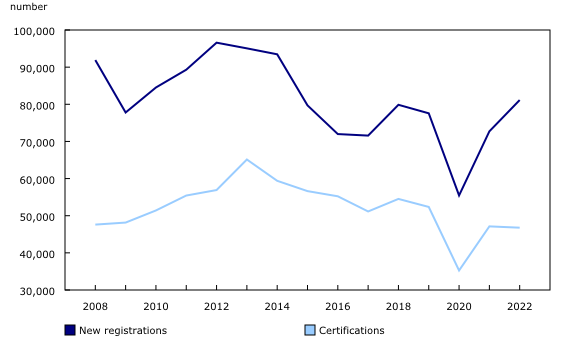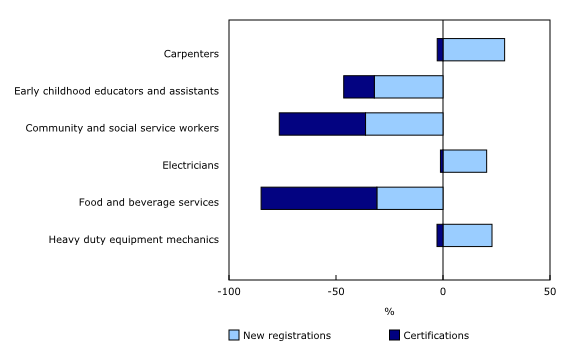Registered apprenticeship training programs, 2022
Released: 2023-12-05
In 2022, 81,141 Canadians registered in an apprenticeship program, an increase of 11.6% (+8,430) from 2021. The number of new registrations in 2022 surpassed pre-COVID-19-pandemic registration levels and marks the highest number of new registrations since 2014. Certifications, by contrast, remained below pre-pandemic levels, having declined by 0.8% (-354) to 46,777 in 2022 from the previous year.
New registrations exceed their pre-pandemic levels for many trades
Across Canada, elevated levels of job vacancies in the trades, transport, and equipment operators and related occupations continued through 2022. These high levels of unmet labour demand in key industries such as construction and fabricated metal product manufacturing further heightened ongoing concerns about labour supply. This coincided with an increase in new registrations in almost every trade compared with the previous year. For some trades, such as carpenters (+28.8%), heavy-duty equipment mechanics (+22.9%) and electricians (+20.4%), the number of new registrations exceeded their 2019 pre-pandemic levels.
By contrast, the number of new registrations in trades such as community and social service workers (-36.2%), early childhood educators and assistants (-32.1%) and food and beverage services (-30.9%) remained below their pre-pandemic levels.
Quebec reports the largest number of new registrations
In 2022, most provinces and territories reported an increase in new registrations from the previous year, with numbers surpassing their 2019 pre-pandemic levels in many jurisdictions. The largest increase in new registrations was in Alberta, up 51.0% (+5,349). This rise comes amid years of decline when Alberta faced economic difficulties following the drop in oil prices in 2014. Quebec (24,723) reported its highest number of new registrations on record in 2022, representing an increase of 2.3% (+558) from the year before. Ontario (+7.2%, or +1,263) and Saskatchewan (+21.9%, or +312) also recorded large gains in the number of new registrations.
The continued impact of the COVID-19 pandemic on certifications in the trades
In 2022, the number of Canadians certifying in the trades remained below pre-pandemic levels. This finding may be attributable in part to the impact that the pandemic and its associated public health measures had on certain trades. For instance, trades in the service sector, such as food and beverage services (-54.1%) and hairstylists and estheticians (-33.7%), were disproportionately affected by the pandemic, and its effects continue to persist three years after the onset of the pandemic. Conversely, certifications exceeded their pre-pandemic levels in a few trade groups, such as landscape and horticulture technicians and specialists (+30.2%), millwrights (+8.5%) and refrigeration and air conditioning mechanics (+4.2%).
The number of certifications in 2022 remained below 2019 levels in all provinces and territories except Ontario, with six provinces reporting decreases in the numbers of certifications compared with the previous year. Ontario reported 13,666 certifications in 2022, exceeding the 13,152 certifications reported in 2019. Increased certifications in electricians (+26.2%) and millwrights (+29.0%) were the primary drivers of this increase.
Note to readers
Context
The provinces and territories, which provide the data for this release, make operational and administrative changes related to the training and certification of the trades within their jurisdictions. These changes may affect historical comparisons. The data should be interpreted within the context of these administrative and operational changes. For further information on federal, provincial and territorial changes, see the Registered Apprenticeship Information System Guide.
Certification
The requirements for granting a certificate vary by jurisdiction in Canada. In most instances, an apprentice is issued a certificate if they complete requirements such as supervised on-the-job training and technical training, and pass one or more examinations. Meanwhile, most trade qualifiers become certified once they pass an examination.
Designated trades
The provincial and territorial jurisdictions determine the trades for which apprenticeship training is made available. These are referred to as designated trades. The jurisdictions also determine which of the designated trades require certification to work unsupervised in the trade. The list of designated trades varies considerably between jurisdictions. Data from the Registered Apprenticeship Information System include only the trades that are designated in at least one province or territory.
Registered apprentices are people who are in a supervised work training program in a designated trade. The apprentice must be registered with the appropriate governing body (usually a ministry of education or labour, or a trade-specific industry-governing body) to complete the training. Some apprentices could be registered in more than one apprenticeship program simultaneously.
Registrations
The reference period is from January 1 to December 31, 2022.
Total registrations: The total number of registrations carried forward from the previous year, new registrations and reinstatements.
- Already registered: The number of registrations carried forward from the previous year.
- New registrations: New entrants to any apprenticeship program within the 12-month reporting period.
- Reinstatements: Registrations by people who had left an apprenticeship program in a specific trade in a previous year and returned to the same apprenticeship program during the reporting period.
Red Seal and non-Red Seal programs
The Red Seal Program sets common standards to assess the skills of tradespeople across Canada in trades referred to as the "Red Seal" trades. Tradespeople who meet the Red Seal standards, through examination, receive a Red Seal endorsement on their provincial or territorial trade certificates.
Non-Red Seal trades, however, do not have interprovincial standards. Many non-Red Seal trades do not require an exam to work in the trade.
Trade qualifiers or trade challengers are people who have worked in a specific trade for an extended period of time, without having ever been an apprentice, and who have received certification from a jurisdiction. This is usually done via a skills assessment in the trade.
Products
The product "Canadian Apprenticeship Registrations and Certifications: Interactive Tool" is now available as part of the series Statistics Canada - Data Visualization Products (71-607-X).
Contact information
For more information, or to enquire about the concepts, methods or data quality of this release, contact us (toll-free 1-800-263-1136; 514-283-8300; infostats@statcan.gc.ca) or Media Relations (statcan.mediahotline-ligneinfomedias.statcan@statcan.gc.ca).
- Date modified:


